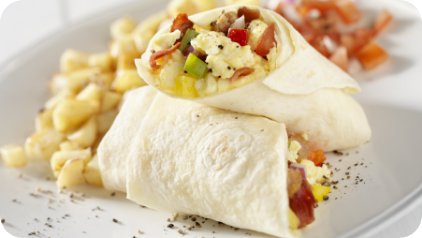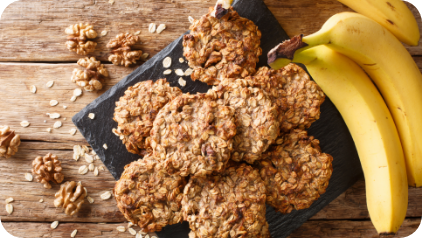Schools with school food programs provide an opportunity for students to access nutritious foods. Nutritious foods are critical for healthy growth and development.
When nutritious foods are offered or sold and consumed at school these can contribute to the health and wellbeing of students and help them be ready to learn and play.
How can school food programs increase students’ access to nutritious foods?
- According to the McCreary Adolescent Health Survey, in 2023 vegetables and fruit consumption was the lowest in 15 years. School food programs can increase opportunities for students to access fruits and vegetables.
- In Canada, the intake of ultra-processed foods is highest among children and adolescents, accounting for more than half of their daily energy intake. School food programs can provide students access to whole and minimally processed foods.
- Currently in BC, most children and youth have inadequate intakes of calcium and vitamin D. School food programs can include more food and beverage sources of calcium and vitamin D.
Growing Generations
Food is a powerful tool for transmitting ancestral knowledge and connecting with history. Through it, kids learn values like respect, abundance, and generosity, enriching their entire lives.
Video: Cúagilákv (Jess Housty), Co-lead at Right Relations Collaborative.
“One of the best things about school lunch is that my kid might be exposed and more willing to try foods at school than he is at home! When he is eating a meal together with his classmates, he sees what others are eating. This gives him a new perspective and helps to build his comfort with different foods. Eating together is also a powerful form of community, and I love that my kid and his schoolmates are all offered a nutritious breakfast and lunch regardless of income or other stigmatizing criteria.”
– Anna, RN, Terrace, BC
The nutrition information provided below can support decisions around foods offered, sold, or served in schools including school food programs, school cafeterias and school events.
Meal and Snack Composition
Offering a variety of nutritious foods, through meals and snacks throughout the day, helps students meet their nutrient needs while also allowing the flexibility to respect personal preferences, dietary needs, cultures and food traditions.
To ensure a variety of nutritious foods are offered, a school meal should ideally offer at least one choice from each of the 3 food categories from Canada’s Food Guide:
- Vegetables & Fruits
- Grains
- Protein
School snacks can also help students meet their daily nutrient needs. For example, some students may not eat much at a particular meal or they may require more food to support their growth and development. Ideally, a snack provides a choice of 2 food categories from Canada’s Food Guide to increase students’ opportunities to have a variety of nutrients. Examples include:
- A Vegetables & Fruits food and a Protein food, such as carrots and hummus.
- A Protein food and a Grain food, such as egg and toast.


Beverage considerations
Water should be readily available to students at all times.
At meals and snacks, schools are encouraged to also offer a beverage that contains at least 25% Daily Value of calcium and is fortified with at least 10% Daily Value for Vitamin D. This can help children and teens meet their daily needs for calcium and vitamin D. Examples include:
- Plain (unsweetened) milk (0-2% MF)
- Plain (unsweetened) kefir (0-2% MF)
- Plain (unsweetened) plant-based beverages (e.g., soy, almond, rice)
Fortified plant-based beverages as alternatives to plain (unsweetened) milk (0-2%MF):
A calcium and vitamin D fortified plant-based beverage such as soy, almond, rice, coconut, hemp, oat or pea beverage can be offered as an alternative to plain (unsweetened) pasteurized milk (0-2% MF). However, not all are fortified with the same amount of calcium and vitamin D. When choosing a fortified plant-based beverage, look for one that contains at least 25% of the daily value (DV) for calcium and 10% DV for vitamin D on the Nutrition Facts Table.
Plain fortified soy beverage is nutritionally equivalent to 2% cow’s milk and is considered a Protein food in Canada’s Food Guide. However, most other unsweetened fortified plant-based beverages are low in protein and fat even when fortified with calcium and vitamin D, and are not considered a Protein food.
Offering a variety of choices for a variety of nutrients
When creating school menus, remember that different foods, even within the same food group, may offer different key nutrients. For example, with the Protein foods, cheese is high in calcium but low in iron while meat or lentils are high in iron but low in calcium. Offering a variety of different protein foods (plant or animal-based) throughout the school week helps children and teens meet their needs for various nutrients.
Consider small, gradual changes
When transitioning to a healthier school menu, it may be easier to start with adding more nutritious foods in, instead of taking foods away or by offering nutritious food options alongside familiar foods. For example, offering baby carrots and plain (unsweetened) milk (0-2% MF) with a deli meat sandwich. For more ideas, visit the Ideas to Increase Nutrition page.
The following Food Lists below provide food and beverage suggestions that are based on the best available nutrition evidence to support children’s healthy growth and development. When menu planning, consider offering, selling, or serving nutritious foods from the ‘Serve Frequently’ section most often.
What does “Serve Infrequently” mean?
The Merriam Webster dictionary defines “infrequently” as placed or occurring at wide intervals in space or time. While menu planning, consider trying to offer the ‘Serve Infrequently’ foods less often. This may look different between schools. For example, if offering a 4-week menu cycle, this could look like offering the food once or twice during the cycle. If offering a 2-week menu cycle, this could look like offering the food once in the cycle.
If looking to gradually decrease the Serve Infrequently foods, one way to start can be by offering them in smaller serving sizes.
Schools are encouraged to make changes to meals and snacks when and where possible to best meet the needs of their student population.
Vegetables & Fruits
Serve Frequently:
- Fresh* vegetables and fruits
- Frozen vegetables and fruits
- Canned vegetables
- Canned fruits (packed in juice)
- Fruit sauces (100% fruit with no added sugar, e.g., unsweetened apple sauce)
- Dried fruits (100% fruit with no added sugar)^
- Cultural plant foods (e.g., seaweed, native berries and roots)**
Serve Infrequently and in smaller serving sizes:
- Canned fruits in heavy syrup
- Battered and/or deep-fried vegetables
- French fries/fried potatoes
- Chips (regular, baked or extruded), including potato chips, corn chips, tortilla chips, veggie chips
- Fruit cups in gelatin/jelly
- Prepared pie filling
- Processed fruit snacks (e.g., fruit leathers, fruit bars and gummies, including those made with 100% fruit juice)
- Frozen fruit bars, popsicles or fruit-based freezies
- Products that are deep-fried, contain sugar substitutes or supplemental ingredients (e.g. caffeine, amino acids)
*Visit buy BC’s Guide to local, seasonal foods to find out when produce is in season in B.C.
**For examples, see: https://www.fnha.ca/Documents/Traditional_Food_Fact_Sheets.pdf
^ Dried fruit can stick to teeth and cause dental cavities. Therefore if choosing dried fruit, ensure it is served with other foods.
Grains (whole grains when possible)
Serve Frequently:
- Grains such as barley, rye, whole oats or oatmeal (unsweetened), bulgur, quinoa, buckwheat, amaranth, millet and foods made with these grains
- Bread products (bread, bagels, tortilla wraps, pitas, buns, bannock, naan, pizza crust, flatbread etc.)
- Rice and rice noodles
- Wild rice, brown rice, red rice
- Pasta (wheat or gluten-free)
- Plain breakfast cereals (e.g., flakes of corn/bran, oat o’s, shredded wheat)
- Plain (non-coated) cereal or granola bars made with whole grains
- Muffins made with whole grains (e.g., oats) or bran, and/or fruit and vegetable*
- Plain crackers
Serve Infrequently and in smaller serving sizes:
- Cookies, bars (e.g., brownies), pastries, croissants, cakes (including cupcakes and cake pops), pies, tarts, donuts or sweet buns (e.g., cinnamon buns)
- Pre-seasoned noodles/pasta or rice
- Canned rice or pasta
- Coated granola bars (e.g., covered in chocolate, “yogurt”) or puffed rice cereal bars
- Energy bars, protein bars
- Toaster pastries
- Cheesies, puffs, twists, crisps, straws, pretzels (regular, baked or extruded)
- Products that are deep-fried, contain sugar substitutes or supplemental ingredients (e.g., caffeine, amino acids)
- Sugary breakfast cereals or granola high in sugar or saturated fat
*Examples: small blueberry bran muffin, oatmeal berry muffin, morning glory muffin
Proteins
Serve Frequently:
- Legumes (beans, peas, lentils, edamame), fresh/canned/dried/frozen
- Hummus or other bean spreads
- Eggs
- Tofu, tempeh
- Chicken, turkey (fresh/frozen)
- Lean beef and pork (fresh/frozen)
- Game (e.g., deer, elk, moose)*
- Extra lean or lean ground meat (e.g., chicken, turkey, beef, pork)
- Fish and shellfish (fresh/frozen)
- Canned fish
- Hard cheese
- Cottage cheese
- Paneer
- Yogurt or Greek yogurt
- Nuts, seeds, nut butters and seed butters**
- Plain (unsweetened) milk (0-2% MF)
- Plain (unsweetened) yogurt drinks
- Plain (unsweetened) kefir (0-2% MF)
- Plain (original or unsweetened) fortified soy beverages^
Serve Infrequently and in smaller serving sizes:
- Commercially battered and/or breaded meat, fish, chicken, turkey (e.g., chicken nuggets, chicken strips)
- Deli meats (e.g., bologna, pepperoni, salami, ham)
- Hot dogs, wieners
- Bacon
- Sausages, pork breakfast links
- Corned beef
- Beef jerky
- Processed cheese – spread, slices or sauce
- Ice cream, frozen yogurt, frozen dessert
- Milkshakes (homemade or pre-packaged)
- Pudding
- Products that are deep-fried, contain sugar substitutes or supplemental ingredients (e.g., caffeine, amino acids)
*Work with your local Environmental Health Officer
**May be dependent on school food allergy policy
^ Other plant-based beverages, like almond and oat, are low in protein and are not part of the Protein Foods.
Beverages
Serve Frequently:
- Water
- Unsweetened carbonated or still water
- Plain (unsweetened) pasteurized milk (0-2% MF)
- Plain (unsweetened) yogurt drinks (0-2% MF)
- Plain (unsweetened) kefir (0-2% MF)
- Plain (original or unsweetened) fortified plant-based beverages
- Fruit smoothies, with no added sugar (made from fresh, frozen or canned fruit mixed with plain (unsweetened), 0-2% MF, yogurt or milk and/or fortified plant-based beverage or plain water)
Serve Infrequently and in smaller serving sizes:
- Beverages containing sugar substitutes
- Coffee, black tea (including iced tea, cold coffee beverages)*
- Flavoured waters with added sugars
- Fruit-flavoured drinks (e.g., lemonade, cocktails, punch)
- Hot chocolate
- Milkshakes
- Slushy drinks
- Soft drinks
- Sport and/or electrolyte replacement drinks
- Sweetened milk
- Sweetened flavoured plant-based beverages (“original” may be offered)
- Vitamin fortified water
- 100% fruit juice
* Caffeine is not recommended for children under the age of 12. Even for youth over the age of 12, Health Canada’s maximum recommended intake is quite low and equivalent to about 237 mL (1 cup) of coffee or less. Visit Health Canada’s page on Caffeine in Foods to learn more.
There is no need for sugar sweetened beverages to be offered, sold, or served in schools. These beverages contain little to no nutrients and contain high amounts of added sugar. Beverages high in sugar also increase the risk of cavities.
Energy drinks are not recommended for children and teens because of the amount of caffeine, added sugars and other supplemental ingredients (like herbs and amino acids) they contain.
Condiments
Condiments and other minor ingredients such as fats and oils and seasonings:
-
- can help enhance flavour
- can increase students’ acceptance of foods and,
- may be used in the preparation of mixed dishes.
For example, adding cream cheese to a bagel, adding a bit of brown sugar to oatmeal, or having ketchup or ranch dip with vegetables, can make these foods more appealing to students. Since many of these items can be high in sugar, sodium or fat, it is best to offer them in small amounts and serve them on the side whenever possible.
Examples of condiments include:
-
- Cream cheese
- Dips (e.g. guacamole, tzatziki, baba ghanoush)
- Dressings (salad dressing)
- Gravies
- Herbs and spices *
- Horseradish
- Hot sauce
- Jam, jellies, marmalade, fruit butter
- Ketchup
- Kimchi
- Mayonnaise
- Mustard
- Nutritional yeast
- Oils (canola, olive, safflower, soybean, sunflower, etc.)
- Pepper*
- Olives, Pickles
- Relish
- Salsa from a jar
- Salt
- Sauces and chutneys
- Sauerkraut
- Soft margarine or butter
- Sour cream
- Soy sauce
- Spreads
- Sugar, brown sugar, honey, syrup
- Traditional fats (whale, seal, bear, duck, goose, etc.)
- Vinegar*
- Wasabi
- Whipped cream
* plain herbs and spices (including pepper) and plain vinegar do not contain added sodium, sugars or fat
When planning for meals or snacks, other considerations may include food allergies, supporting students with diverse abilities or incorporating Indigenous Foods. See the Safety & Inclusion section.
The School Food Program pages provide sample meal plans for Grab n’ Go, Assemble-and-Serve and Cooked-from-Scratch program models. See the Recipes pages to access batch-cooking recipes suggested in the meal plans and links to more recipe ideas.

